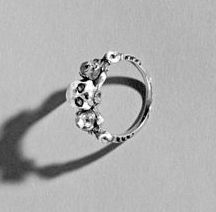The houses the middling sort lived in were, some of them, like the modified hall house described earlier, with a hall and parlour downstairs and stairs to the upper chambers. If the chimney was centrally placed, visitors could be shown either to the hall or to the parlour, and it could help support a staircase. Glazing was becoming affordable, and dormer windows were introduced to utilise roof spaces more efficiently. In more modest houses, there were fewer rooms of specialised use and rarely more than one chamber for sleeping. First floor rooms might be reached by a ladder rather than a staircase well until well into the century. Not all the hall houses in Hythe had been converted by the early seventeenth century. In 1625, John Banbury, a carpenter, was leased a house by the corporation on condition that he built a chimney and flue in brick, with fireplaces in two rooms.
Most houses were completely or largely wooden, with oak favoured. Wattle and daub was used to infill between the timbers, but by the seventeenth century exteriors were being improved. Sometimes brick was used to enclose a timber structure and the use of weatherboarding and tiling increased.
Houses were also workshops, places of manufacture, offices, warehouses and retail shops. Almost the whole of trade was small scale and domestic, although from inventories we can tell that domestic quarters were separate from workshops. In seventeenth century Hythe there was no commuting to work unless you were a fisherman.
Some houses had gardens, but often these had been used for building a cottage or two to rent out. Those householders who found themselves without a garden often leased one elsewhere to grow vegetables for the kitchen, like Robert Foster, a fisherman who kept a garden at the back of the ‘George’ inn (now the ‘King’s Head’). Some had small orchards too. There was also a physick garden maintained by John Jacob, which supplied the town’s physicians with the herbs they needed for their remedies – perhaps pennyroyal for vertigo, burdock for flatulence, fleabane for itchy bites, pennywort for bladder complaints, or rue, for almost anything. Jacob also diversified with land ownership on the Romney Marsh ‘which he manures with sheep and some other land he sows with flax’. Flax needs soaking, or retting, before it can be used to make linen. Jacob unwisely chose the town ditch in which to ret his, blocking it and causing a terrible stink, metaphorically and literally.
The universal presence of timber and thatch combined with the use of fire for domestic cooking and heating resulted in a huge fire risk. In 1655 the corporation issued a decree against carrying fire in an uncovered container. If a household fire went out, the simplest way to get it alight again was to fetch a burning log or coal in a bucket from a neighbour, rather like borrowing a cup of sugar. This resulted, as the corporation minutes eloquently put it, in the ‘sad spectacle of God’s judgement upon several places by the Rage and Power of that unmerciful element of Fire’. The order was clearly unsuccessful, as during the next five years there were several more fires. In 1660, the corporation changed their focus and ordered that all houses whose thatch touched another house should be tiled instead. All rate payers were to pay an additional tax so that the corporation could provide buckets, hooks and chains for carrying water to fight fire. Hythe would not get a proper fire brigade until a hundred and forty years later.
The possessions inside the houses depended on the wealth of the occupant, and as the century wore on people of the middling sort can be seen to be acquiring more home comforts and articles which were purely decorative. In 1625, John Gately, a blacksmith, had three pewter cups, but another blacksmith, John Clement, who died in 1696 had pewter, but also two silver cups and silver spoons. In 1647, Baker Godden, a husbandman, had a pair of playing tables (for cards) and five pairs of pictures; in 1653 Thomas Hooker, a butcher left his ‘gold ring with deathly heads’ to his daughter Susan (memento mori rings had been popular since the beginning of the century) and Catherine Littlewood, the miller’s widow, left silver spoons to her children. The most noticeable increase is in ownership of looking glasses and chairs. Chairs were a rarity among ordinary people at the beginning of the century, but most houses had at least one by the end of it.Peter Johnson, a baker, even had one upholstered in turkey-work, a sort of woollen tapestry, and he also, unusually, had ‘a small brass clock’ On the other hand, inventories can also show that disaster was never far away. Michael Hammon who died in 1622 has goods worth only three pounds one shilling and sixpence, but he owed money totalling three pounds eight shillings and tenpence to four creditors. Robert Wakelin, a tanner, left goods and money worth over a hundred and twenty pounds in 1693, but of that, over half was in money owed to him.


Well done. Another entertaining and informative entry.
LikeLike